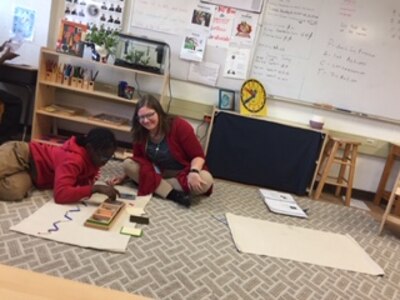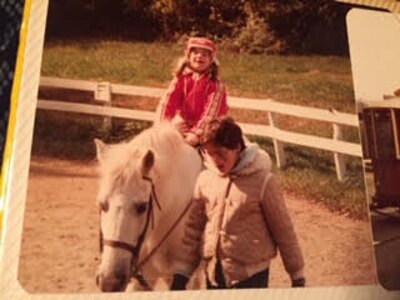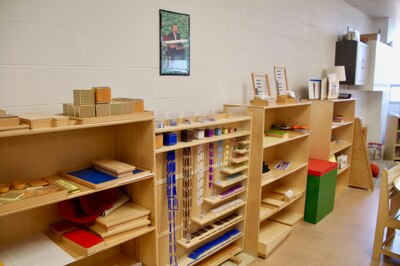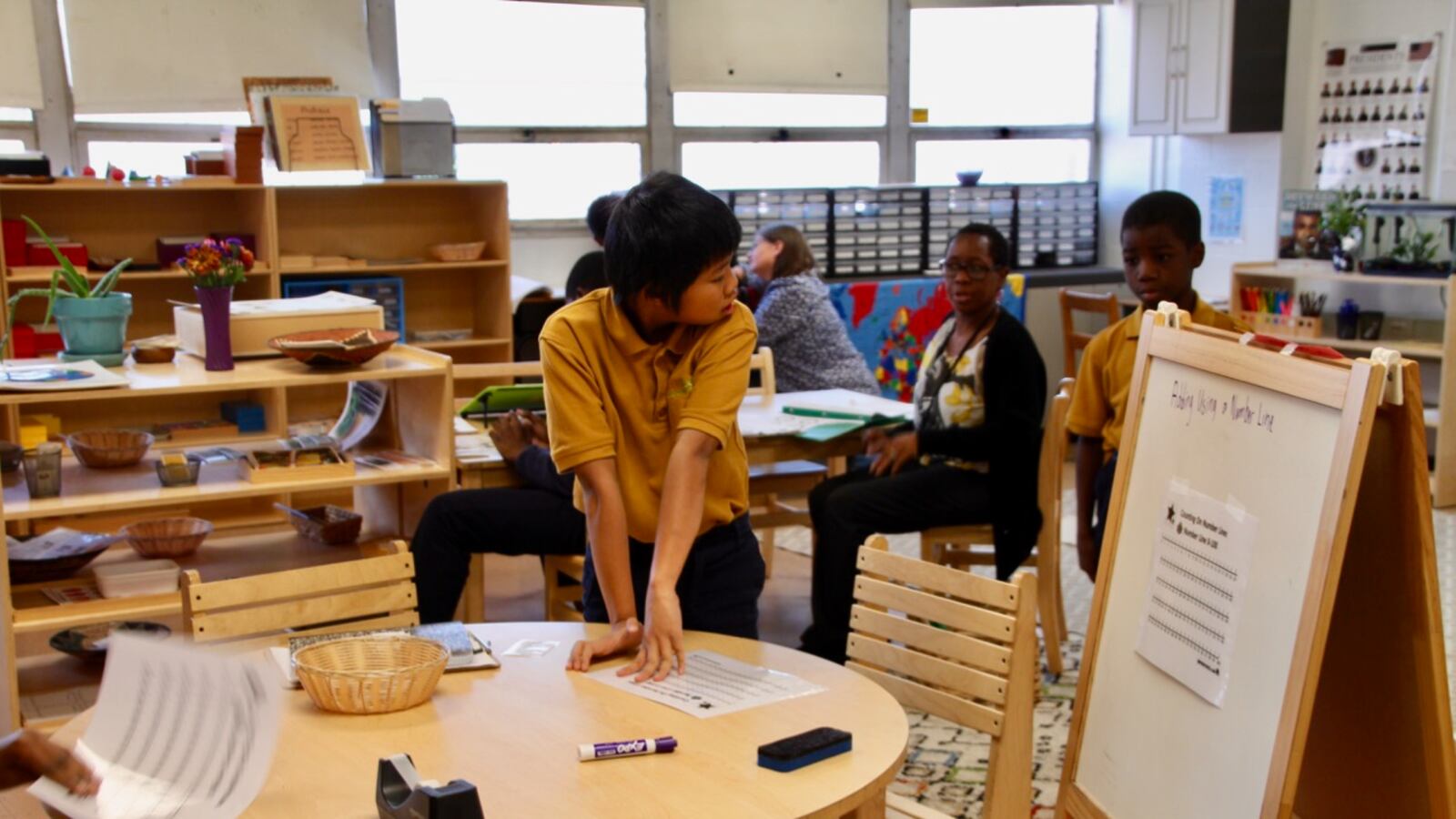Here, in a feature we call How I Teach, we ask educators who’ve been recognized for their work how they approach their jobs. You can see other pieces in the series here.
Jamilyn Cole’s own experiences as a young student with disabilities put her on a long, winding path to becoming a special education teacher herself.

“I was surrounded by stories of Helen Keller, Stevie Wonder, Ray Charles, and Louis Braille,” said Cole, adding that the books on artists and leaders who had disabilities were a large inspiration to her. “By second grade I told my family that I wanted to be a preschool teacher of deaf or blind children.”
Cole – who was diagnosed with dyslexia, dysgraphia, and dyscalculia – first spent more than a decade after college working for museums and in youth development. At age 37, she joined Teach for America to become a teacher in Memphis, finding herself in a special education classroom once again.
She now teachers third- through fifth-grade special education at Libertas School of Memphis, a Montessori school in the Frayser neighborhood. It’s a part of the Achievement School District, a district of charter schools that took over historically low-performing schools.
Cole’s classroom is set up like a typical Montessori classroom, where students work on independent lessons and have more autonomy than in traditional schools. But it’s much smaller in size with 12 students to two teachers. Her students also spend time with the school’s speech, occupational, and physical therapists.
About a quarter of the 364 students at Libertas have a disability. About 13 percent of students in the achievement district have disabilities, which is right at the state average for all Tennessee districts.
We spoke with Cole about her own experience growing up in special education, what her Montessori classroom looks like (and why looks matter), and what she wishes people understood about teaching students with disabilities.
The interview has been lightly edited for length and clarity.
Was there a moment when you decided to become a teacher?
Growing up as a special education student myself, I was surrounded by stories of Helen Keller, Stevie Wonder, Ray Charles, and Louis Braille. By second grade I told my family that I wanted to be a preschool teacher of deaf or blind children. I stayed committed to that goal for many years and during my freshman year of college, I was even a deaf education major. However, shortly after that I took a detour into my second love, history. I spent the next 15 years working in museums and youth development.
At the age of 37, I had the opportunity to join Teach For America and become a teacher in a kindergarten classroom after many, many years of first declaring that was what I wanted to do with my life. At the end of that year, my assistant principal asked me if I’d consider moving into a special education role in the following year. It was one of the best moves of my career.
How did you become aware of your disability? How have your experiences shaped you in the classroom?
I’ve known my whole life. My mom always explained it to me: “I needed a little more help then some other children with some things, but that’s OK because we all have strengths and weaknesses.”
I remember bits and pieces of my preschool experience, where I was exclusively with other kids with disabilities. I still have fond memories of getting to be in the Special Olympics and a therapeutic riding program. By kindergarten, I was mainstreamed – that’s the language we used in the 80s to mean I was put in a traditional classroom setting. While I certainly didn’t know that language at 5 years old, I did know that I left my classroom for speech and physical therapy weekly. I continued in physical and speech therapy for the next five years. By third grade my learning disabilities were diagnosed and I was now leaving the room with a special education teacher to work on math, writing, and spelling skills due to my dyslexia, dysgraphia, and dyscalculia diagnosis.

I started going to my own meetings for my special education plans in middle school and shortly after was advocating for my own accommodations, which I continued into college and the workforce. It wasn’t until I was an adult working at my first job out of graduate school, struggling to manage my workflow and stay organized, that I was finally diagnosed with adult ADHD. Learning disabilities don’t go away when you finish school.
As an adult I’m very transparent about my struggles in school to staff, parents and students. It’s helped me help soothe a parents’ concerns or fears when a child is first being diagnosed and they don’t know what the future might hold for them. I remember how hard my mom, teachers, and I had to advocate for accommodations that I needed like additional time on tests, assistive technology, dictation, audiobooks and more. I know as a child what it’s like to feel like everyone else was learning something and I couldn’t. But I also know what it’s like to keep working at something until it finally clicks.
Due to my own struggles, I am always trying to find a way to make learning as concrete and hands-on as possible, which fits perfectly with Montessori. History always seemed to come naturally to me, and I was immersed in it from a young age, having grown up in Virginia. As a child, I wrote with a quill pen, visited Mount Veron, and saw Native American artifacts at Jamestown. While I can’t take my children to all those places, we have made our own ink from berries, written with a quill pen, and held Native American artifacts.
How are the set up and aesthetics of your classroom different than a traditional classroom? Why is that important when teaching students with disabilities?
A Montessori elementary classroom is purposefully set up very differently than a traditional classroom. There are no desks in rows but tables for small groups of students to work together or independently. As a teacher, I am not at the front of the room, but usually on the floor or at a table presenting a lesson. We always have at least two educators in a classroom.
The floors are often covered with beautiful carpets, so students can do large work comfortably on the floor. You won’t find bright, “kid-friendly” decorations on the walls, but rather beautiful art. The brightest objects in the room are meant to be the materials on the shelves, so the students will be attracted to the material and excited to work with them. We keep the lights low and soft music on to help maintain a calm environment. In addition, we have a sensory shelf where students can access headphones, sensory bottles, fidgets, and other tools that they might need.
A Montessori classroom is always designed to serve three grade levels. In working with students with disabilities, this is especially important because it means I already have a variety of materials, and students know in a Montessori classroom that they will be working on different things as they need them and that’s ok.
How do you get to know your students?
Getting to know your students isn’t something that happens all at once or overnight. I try to meet all of my students and their families before school starts in the fall. From that moment on, I’m always getting to know my students. Some of the best moments are during breakfast, recess or during a transition; it’s in those moments when I really need to be present and focus on the tidbits of information they’re sharing with me. When I do that, then I know whose family has a new baby brother or sister, whose grandmother is sick, what their favorite movie is, whose favorite animal is the orca, and so on.
Tell us about a favorite lesson to teach. Where did the idea come from?
With our Montessori materials and curriculum, there are so many lessons that come alive in a way that I haven’t seen in traditional classrooms. One of my favorites is the “Timeline of Life” or evolutionary timeline. This is a timeline about 3 feet wide and 10 feet long. As it’s unrolled, colorful illustrations reveal a great variety of life forms that have existed in the last 600 million years or so. Along the top of the timeline are bands showing the geological eras and periods, along the bottom are inset pictures of maps showing location of landmasses.

In the first presentation we pick a few animals or plants and tell their stories: give defining features and discuss how they adapted to their environment over time in the Earth’s history. This makes such an incredible impression on the children. For many students, this is the lesson that gets them interested in research for the first time. This year, our students chose an animal from the timeline they wanted to learn more about. After investigating that animal here at school, we went to the Pink Palace Museum in Memphis so they could continue their research. As a former museum educator, I of course love when we can use museum resources in the classroom in addition to field trips.
What’s something happening in the community that affects what goes on inside your class?
Many in our community are struggling with poverty, violence, incarceration, access to services, food insecurity, and trauma. Our community is also filled with parent and community advocacy groups working to empower each other.
Our students aren’t always able to complete reading homework because they don’t have access to books at home. Fortunately, our school has just started a new lending library to help meet that need.
And our families are extremely involved in our school. We have over 2000 hours of family involvement every year. Families volunteer, visit classrooms, and come to our many family events. That is a giant help to our teachers.
What do you wish people outside of the education community (or maybe even within) understood about teaching students with disabilities?
Students with disabilities have strengths and weaknesses just like the rest of us. Every student has strengths that we can build on.
Having a disability does not mean one can’t learn or won’t, it simply means the student may need to be taught in a different way. Having a disability doesn’t necessarily mean that a student won’t be able to go onto secondary education or have meaningful work.
What part of your job is most difficult?
One of the most rewarding and difficult parts of my job is teaching our students emotional regulation skills. Our students struggle to regulate their emotions and how they relate to others. However, I’m blessed to work with an amazing classroom team, school team, therapists, and families who all support our students.
What are you reading for enjoyment?
In typical fashion for someone with ADHD, I’m always reading multiple books at once! I just finished “Mindfulness for Teachers: Simple Skills for Peace and Productivity in the Classroom” by Patricia Jennings, which was a refreshing read.
I’m currently reading “The Yes Brain” by Dan Siegel, which was recommended by our wonderful school counselor and is changing how I look at students’ emotional responses. I’m also reading “How To Be An Anti-Racist” by Ibram X. Kendi.


